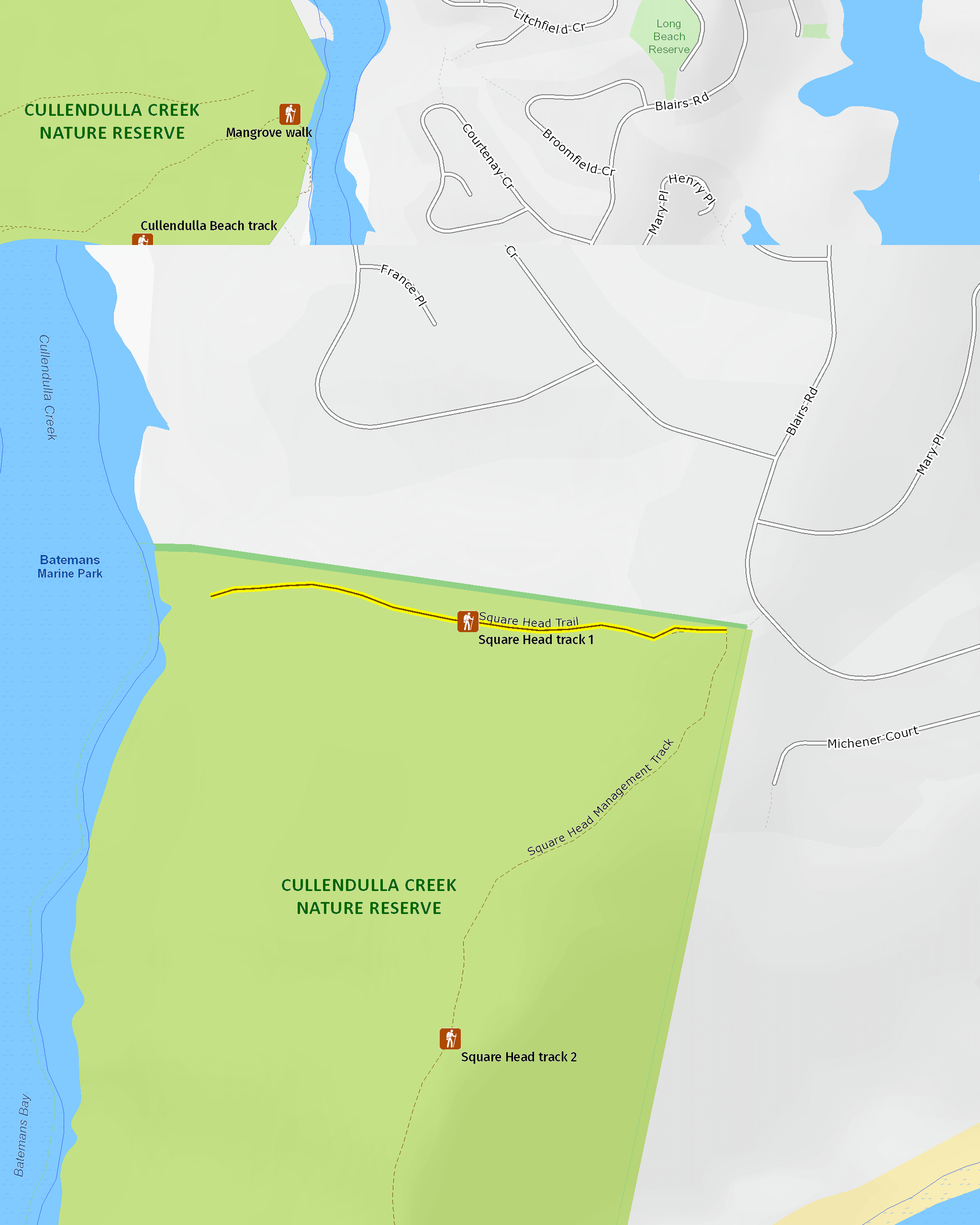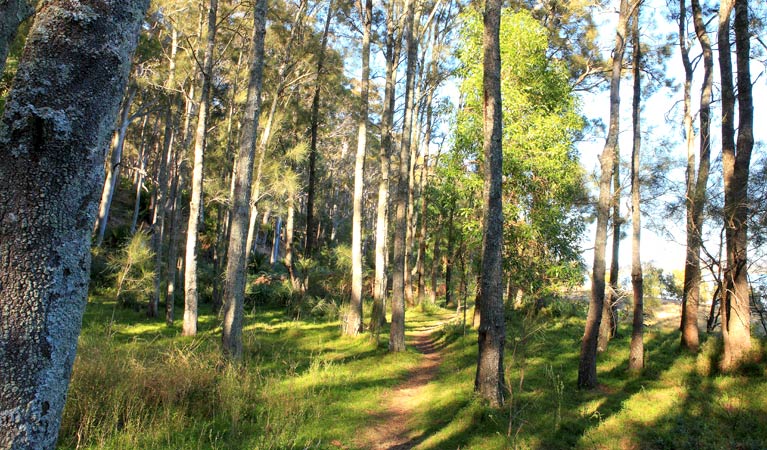Overview
This short walk offers rich rewards, leading to the entrance of Cullendulla Creek, perfect for an afternoon picnic and swim near the shorebirds.
- Accessibility
- Hard
- Distance
- 0.8km return
- Time suggested
- 15 - 30min
- Grade
- Grade 3
- What to
bring - Hat, sunscreen, drinking water
- Please note
- Shore birds are best seen on low tide. It’s a good idea to check the tides charts beforehand. Remember to take your binoculars if you want to birdwatch.
Leading to the entrance of Cullendulla Creek, this terrific short walk touches swamp oak and spotted gum forest before revealing a peaceful beach and rest spot in sight of Cullendulla Beach and the Batemans Bay township.
Expect a moderate-to-steep gradient, but it’s worth it. Pack a picnic lunch and bring the kids along, or bring a birding guide and watch white ibises and black swans drift across the creek. In the warmer months, this is an ideal place for a swim, too; the small estuary beach is protected from onshore winds by Square Head, and the bay, though unpatrolled, is calm enough for swimming. If you fancy a round of fishing, turn left at the carpark and follow the other Square Head track instead.
Map

Map legend

Local alerts
For the latest updates on fires, closures and other alerts in this area, see https://www.nationalparks.nsw.gov.au/things-to-do/walking-tracks/square-head-track-1/local-alerts
General enquiries
- National Parks Contact Centre
- 7am to 7pm daily
- 1300 072 757 (13000 PARKS) for the cost of a local call within Australia excluding mobiles
- parks.info@environment.nsw.gov.au
Park info
- in Cullendulla Creek Nature Reserve in the South Coast region
Cullendulla Creek Nature Reserve is always open but may have to close at times due to poor weather or fire danger.
Visitor info
All the practical information you need to know about Square Head track 1.
Track grading
Features of this track
Distance
0.8km return
Time
15 - 30min
Quality of markings
Clearly sign posted
Experience required
No experience required
Gradient
Short steep hills
Steps
No steps
Quality of path
Formed track
Getting there and parking
Square Head is in the eastern section of Cullendulla Creek Nature Reserve. To get there:
- Take Cullendulla Drive east off the Princes Highway (signposted to Long Beach)
- Take the turn on to Blairs Road and turn off into the nature reserve carpark
- The walk starts right of the carpark and heads down the hill
Parking
Open plan parking is available.
Best times to visit
Spring
Migratory birds arrive from Russia, Asia, northeast China, and Europe for the warmer months, foraging on the sand flats where you can see them from Cullendulla Beach.
Summer
Break out the canoe or kayak and beat the summer heat with a refreshing paddle up Cullendulla Creek.
Winter
Make the short hike to Square Head to do the Mangrove walk, watching how the landscape changes in high and low tide.
Weather, temperature and rainfall
Summer temperature
Average
15.5°C and 23.5°C
Highest recorded
43.3°C
Winter temperature
Average
6.5°C and 17.2°C
Lowest recorded
0°C
Rainfall
Wettest month
March
Driest month
August
The area’s highest recorded rainfall in one day
275.3mm
Facilities
Drinking water is not available in this area, so it’s a good idea to bring your own.
Maps and downloads
Accessibility
Disability access level - hard
Wheelchair access is available, though you will need strong assistance to return to the car parking area.
Permitted
Fishing
A current NSW recreational fishing licence is required when fishing in all waters.
Recreational fishing is allowed in the bay. However, Cullendulla Creek is a sanctuary zone, so it’s a good idea to check the recreational fishing maps for permitted activities.
Prohibited
Pets
Pets and domestic animals (other than certified assistance animals) are not permitted. Find out which regional parks allow dog walking and see the pets in parks policy for more information.
Smoking
NSW national parks are no smoking areas.
Learn more
Square Head track 1 is in Cullendulla Creek Nature Reserve. Here are just some of the reasons why this park is special:
Aboriginal culture

Cullendulla Creek holds several ancient Aboriginal midden sites, including rarely recorded mounded midden sites. The Mangrove walk is a great way to engage with the past lives of people here, weaving through areas where mud oysters, mussels and shellfish were once collected.
Birdwatchers' haven

Cullendulla Creek Nature Reserve is home to mangrove estuary (and two mangrove species, the grey and river mangroves), forest red gums, littoral rainforest, and sea grass beds. The reserve is also a fish nursery for the Clyde River. Unsurprisingly then, a substantial mix of forest and shorebirds visit the area annually, including white ibises, curlews, two species of spoonbill and several of duck. Migratory birds come from as far away as Russia, taking refuge in the warm weather.
- Cullendulla Beach track A secluded stretch of sand in the protected waters of Batemans Bay, Cullendulla Beach offers terrific swimming, birding and a great place to launch a canoe up the creek.
- Square Head track 1 This short walk offers rich rewards, leading to the entrance of Cullendulla Creek, perfect for an afternoon picnic and swim near the shorebirds.
Remarkable dune formations

The nature reserve contains important and unusual dune formations called cheniers. Roughly parallel to the shoreline, these long, low (3-6m) and narrow ridges overlay estuarine mud and are of great scientific interest for the information they provide about the evolving landscape - some 7000 years worth of changes. There are nine beach ridges at Cullendulla; the most northerly two are cheniers. Though they're not directly visible to visitors, a fascinating boardwalk tracks through the mangrove estuary, accompanied by signs which offer a keen insight into the local ecosystem. For the best overview, visit in both high and low tide and compare the differences.
- Mangrove walk An easy walk offering great birdwatching opportunities, Mangrove walk is partly along an elevated boardwalk, giving an insight into the unusual dune formations.

